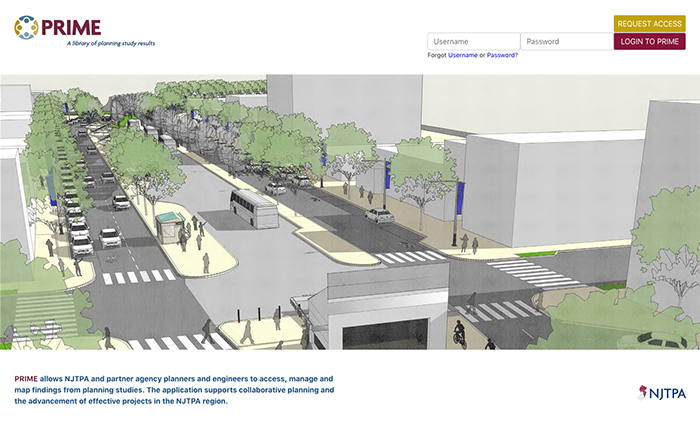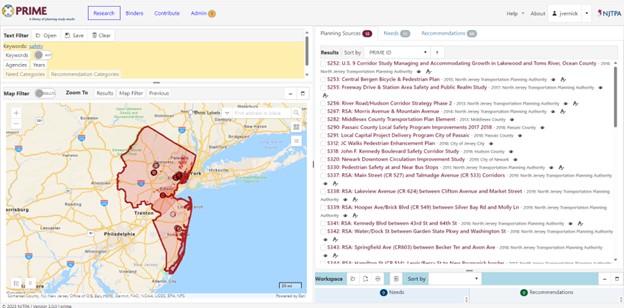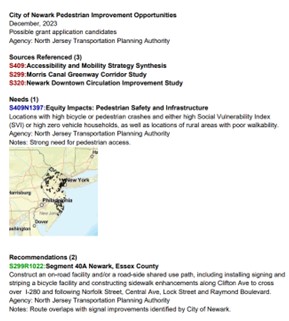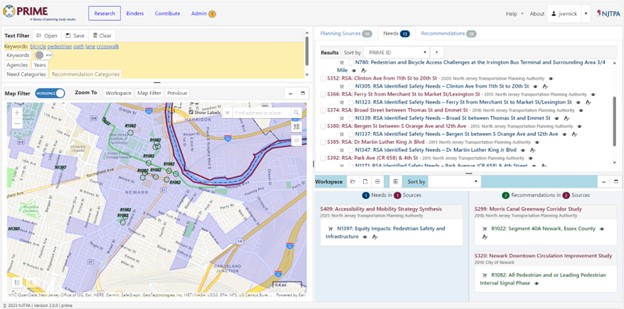PRIME

What is PRIME?
PRIME is a searchable online library of planning studies, with needs and recommendations identified by the NJTPA and its many partner agencies. Whether searching by category filters or by selecting locations on the map interface, PRIME’s multiagency, multimodal findings provide planning context when researching places, facilities, and jurisdictions, and contribute to improved collaboration and project development.

PRIME 2.0 Upgrade
Since 2017, PRIME has provided NJTPA and partner agency staff with a library of planning study findings in the NJTPA region. Featuring dozens of studies and hundreds of location-specific needs and recommendations (and continuing to grow), PRIME has supported reviews of problem statements and project development.
Introduced in January 2024, the NJTPA's upgraded PRIME 2.0 offers improvements in ease of use and performance. Key upgrades include: simplified data entry, streamlined user and administration interfaces, more powerful search and reporting features, and an updated programming platform to provide improved system performance.
What does PRIME do?


-
Provides a central online application to manage, maintain and distribute planning study documents and findings.
-
Makes studies and their specific planning needs and recommendations fully searchable by agency, facility, jurisdiction, or other attributes.
-
Supports identifying relationships among study findings.
-
Generates customized summary reports.
-
Contains reporting tools to support collaborative discussions.
-
Supports the NJTPA’s performance-based planning and programming process by connecting transportation needs and recommendations with regional planning goals and investment strategies.
How does PRIME work?
PRIME searches and stratifies planning findings based on category, keyword, or custom map location filters. This information is organized in a tiered structure of planning products and their specific detail results as follows:

-
PRIME source records document information about each planning study and policy. Reports are often attached.
-
Each source's specific mobility, safety, reliability, sustainability, equity and other problems or opportunities for improvement are documented as need records. Examples include:
- Delay or safety concerns at intersections and on roadways
- Impediments to bicycle and pedestrian travel
- Roads and bridges in need of repair or rehabilitation
-
Each source's specific solutions or strategies are included as recommendation records. Examples include:
- Proposed enhancements to public transit services
- Upgrades to intersection signals, turn lanes and signs
- New sidewalks, crosswalks and bike lanes
- Safety, drainage and lighting improvements on roadways
- Findings can be reported or exported for further planning uses.
How can PRIME support my work program?
-
Identify previous work within study areas for new studies and projects.
-
Screen capital program and engineering projects for needs and policy context in specific locations.
-
Support problem statement development and reviews.
-
Identify interagency collaboration opportunities.
-
Support grant program screenings and selection.
Who can access PRIME?
PRIME is designed to support work activities by NJTPA staff and staff from member subregional and partner agencies (NJDOT, PANYNJ and NJ TRANSIT).
For more information, please contact Jeffrey Vernick.